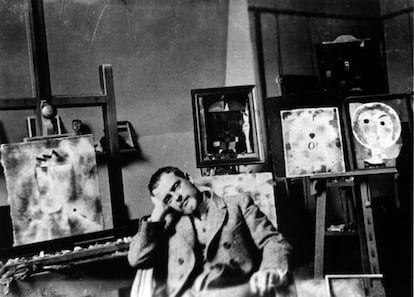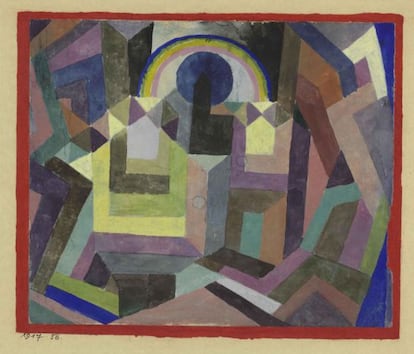Paul Klee - theory and practice
Exhibition at Juan March Foundation explores painter's time as a Bauhaus teacher

Best known for his simple stick figures, suspended fish, moon faces, eyes and arrows, Swiss-German painter Paul Klee produced some of his most important work between 1921 and 1931, when he was a teacher at the Bauhaus in Weimar and Dessau alongside Wassily Kandinsky, Lothar Schreyer and Oskar Schlemmer.
The Bauhaus was founded in 1919 by Walter Gropius as a practical school for aspiring designers. The training was structured into a theory course on Formative Creation and a practical apprenticeship, in which the focus was on the design of objects and furniture, as well as architecture.
Paul Klee. Maestro de la Bauhaus (Bauhaus master), which opens on March 22 and runs until June 30 at the Juan March Foundation in Madrid, presents a selection of 137 of Klee's paintings, watercolors and drawings executed between 1899 and 1940, alongside nearly 100 manuscripts chosen from among his lecture notes.
The exhibition also includes objects and documents that range from contemporary photographs to the artist's herbariums, some of his reading materials, documentary sources for his thinking, his writing, his drawing notebooks, and his publications.

"It is a multifaceted collection of material that hopefully allows us to contextualize his life and work at the Bauhaus in Weimar and Dessau and clarify the mutual influences between his theory and his artistic practice throughout his life," says Manuel Fontán, the Juan March exhibition head.
During his time at the Bauhaus, Klee wrote lecture plans on Pictorial Formation and almost 4,000 pages of teaching notes, which he described in its entirety as "Teaching Notes on Pictorial Creation." He did not teach emerging artists, but "creators, working practitioners."
"The notes are full of striking diagrams, schematic illustrations, tables, color spectrums, constructions and drawings. These notes and illustrations center on the notion of pictorial form, its regular features, governing principles and genesis; on geometry, planes and volumes; on movement; on natural and artificial structures; on configuration in the plastic arts; on rhythm and on color: in short, a series of meditations on the life of forms, without which one cannot definitively understand Klee's own theory or his artwork," says Fontán.
The Juan March Foundation conceived this second exhibition in parallel with the study, transcription and critical edition of that immense legacy, a task that was carried out by Fabienne Eggelhöffer and Marianne Keller-Tschirren, the exhibition's guest curators. This effort has resulted in the publication of the online resource www.kleegestaltungslehre.zpk.org, inaugurated in August 2012. The website provides free access to the database containing complete facsimiles and transcriptions of the texts.
He developed his teaching on the basis of thoughts about his own artistic activity"
Klee was born on December 18, 1879, in Münchenbuchsee, near Bern, Switzerland. His training as a painter began in 1898 when he studied drawing and painting in Munich for three years. By 1911, he had returned to that city, where he became involved with the German Expressionist group Der Blaue Reiter (The Blue Rider), founded by Wassily Kandinsky and Franz Marc in 1911. Klee and Kandinsky became lifelong friends, and the support of the older painter provided much-needed encouragement. Until then, Klee had worked in relative isolation, experimenting with various styles and media, such as making caricatures and Symbolist drawings, and later producing small works on paper. His work was also influenced by the Cubism of Pablo Picasso and Georges Braque, and the abstract translucent color planes of Robert Delaunay.
He died in 1940 at the age of 60, having left Germany after Hitler came to power.
"Klee believed that it is not the final form that is important, but the path to its achievement, which runs as a dominant idea through his teaching. He constantly emphasized that a form does not exist, but becomes. Therefore he researched its interior and its formation. Using existing growth phenomena in nature he illustrated the forming of abstract constructions, particularly at the start of his teaching," says Fontán.
"It is important to remember that Klee's lecture notes are not sketches of his works," insists Fontán. "He developed his teaching on the basis of his thoughts about his own artistic activity. Nevertheless, his work and teaching are two independent areas that occasionally come into contact with one another. So in some of his works Klee playfully applied the design processes he was teaching. Five aspects are of great significance both in Klee's work, as well as in his teaching: nature, color, rhythm, movement and construction. A selection of works shows that Klee was occupied with these themes before, during, and after his activity at the Bauhaus. The aim of his teaching was to convey to the students the fundamental principles of pictorial creation. Like Gropius he was convinced that art itself cannot be taught, but can only arise through intuition."
Tu suscripción se está usando en otro dispositivo
¿Quieres añadir otro usuario a tu suscripción?
Si continúas leyendo en este dispositivo, no se podrá leer en el otro.
FlechaTu suscripción se está usando en otro dispositivo y solo puedes acceder a EL PAÍS desde un dispositivo a la vez.
Si quieres compartir tu cuenta, cambia tu suscripción a la modalidad Premium, así podrás añadir otro usuario. Cada uno accederá con su propia cuenta de email, lo que os permitirá personalizar vuestra experiencia en EL PAÍS.
¿Tienes una suscripción de empresa? Accede aquí para contratar más cuentas.
En el caso de no saber quién está usando tu cuenta, te recomendamos cambiar tu contraseña aquí.
Si decides continuar compartiendo tu cuenta, este mensaje se mostrará en tu dispositivo y en el de la otra persona que está usando tu cuenta de forma indefinida, afectando a tu experiencia de lectura. Puedes consultar aquí los términos y condiciones de la suscripción digital.
Últimas noticias
Maduro pleads not guilty before the federal court in New York: ‘I am still the president of Venezuela’
A new test can detect Alzheimer’s from a finger prick
UN team enters Sudanese city of El Fasher after paramilitary massacre: ‘It’s like a ghost town’
A recipe for resistance: Indigenous peoples politicize their struggles from the kitchen
Most viewed
- Gilles Lipovetsky: ‘If you want to live better and fall in love, take Prozac, don’t look to philosophy’
- Alain Aspect, Nobel laureate in physics: ‘Einstein was so smart that he would have had to recognize quantum entanglement’
- Alvin Hellerstein, a 92-year-old judge appointed by Bill Clinton, to preside over Maduro’s trial in New York
- Why oil has been at the center of Venezuela-US conflicts for decades
- Cuba confirms death of 32 of its citizens in the US attack against Venezuela









































